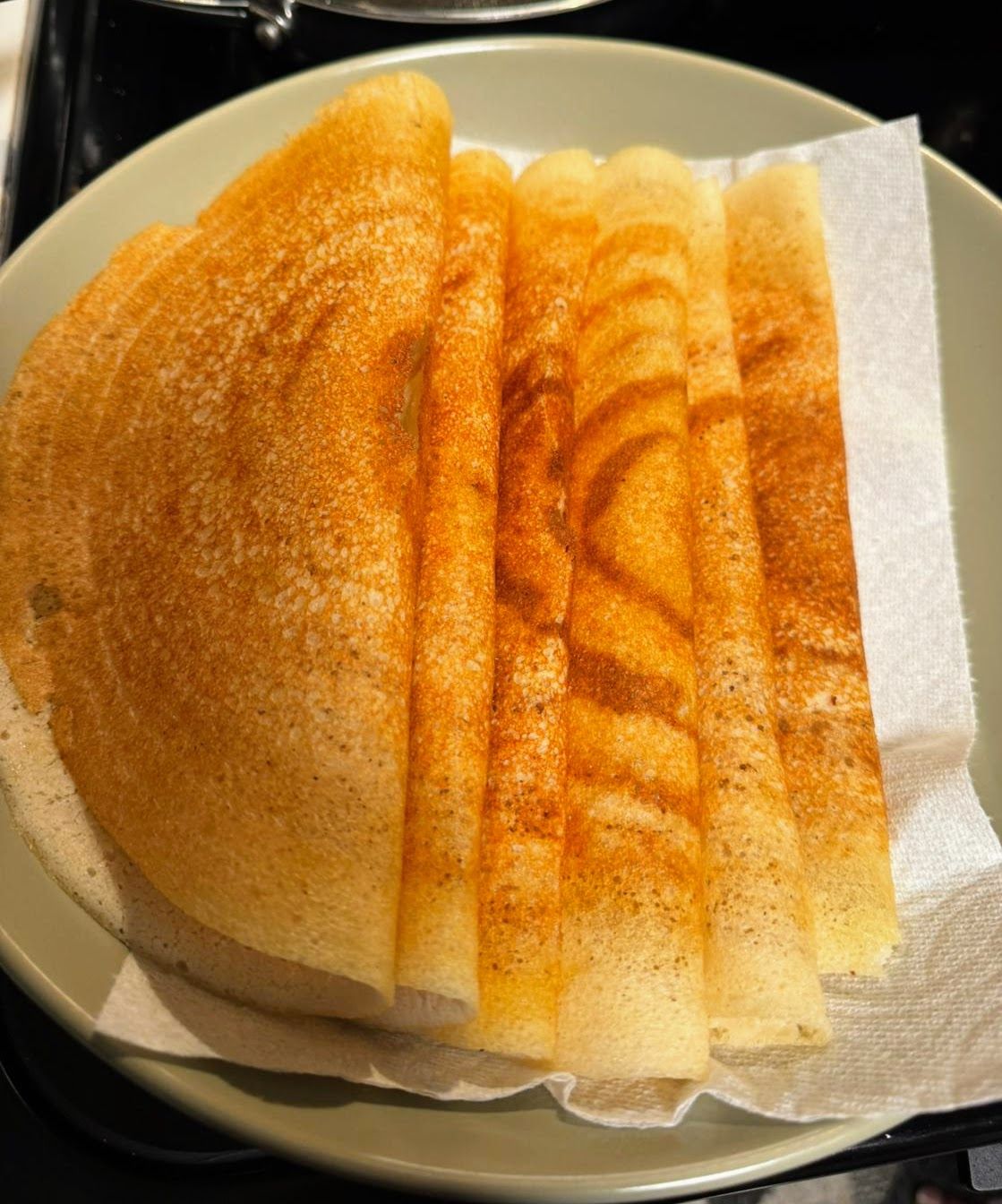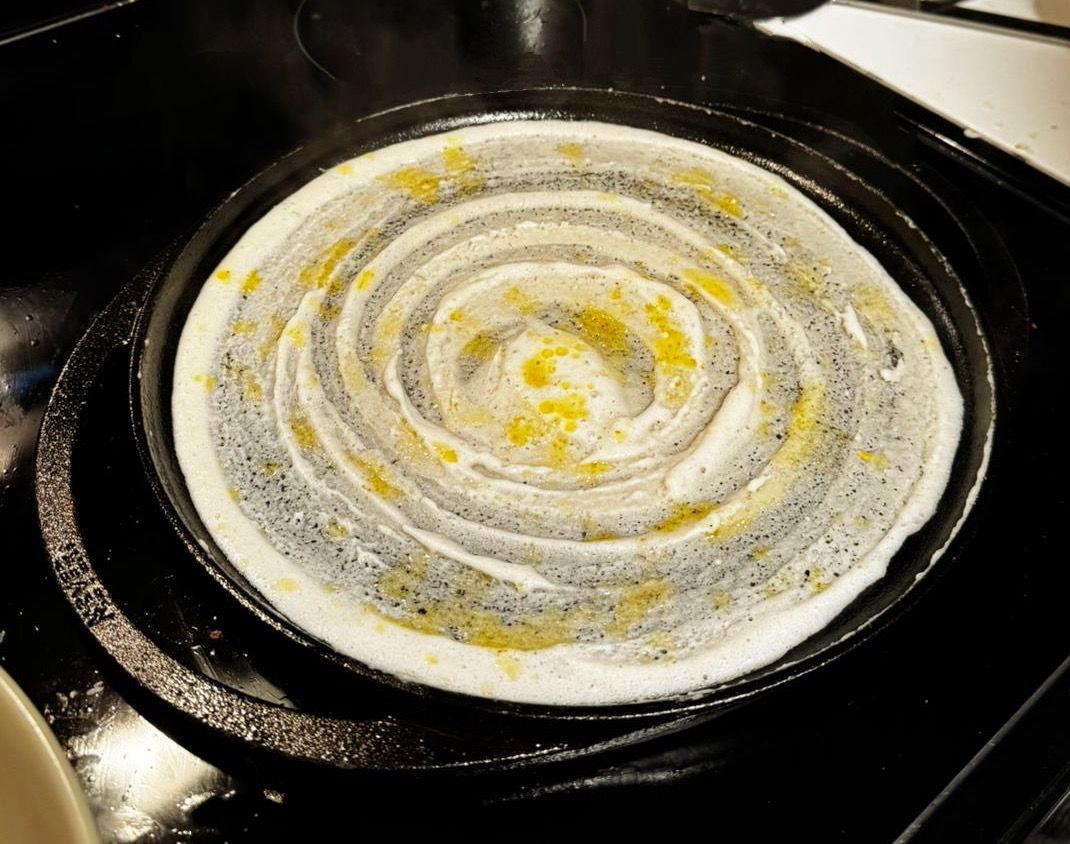Dosa: A dosa is a savory crepe that originated in South India and is a staple food in the region. It's made from fermented rice and lentil batter, and is often served with a side of one or more chutney (south Indian dipping sauce) and sambar (gravy with lentils and vegetables).
Let me start with a confession: I was terrified of making dosa. Humble, crispy, golden, flawless — a perfect dosa felt like a culinary magic trick reserved for South Indian grandmas and street vendors with 30 years of experience. I’d watch street vendors and my mom effortlessly swirl the batter on a hot iron tawa (pan), creating perfect, paper-thin dosas, and think, “Nope, that’s sorcery. I’ll stick to ordering them at restaurants.”
But last year, while clawing my way out of a rough patch, I needed a challenging win. I decided to tackle my culinary nemesis: the dosa. Turns out, conquering dosa taught me more about life (and PM mindsets) than any Gantt chart ever could.
Acknowledge the Fear (Then Ignore It)
My relationship with dosa began as a love story with a tragic third act: admiration → intimidation → avoidance. I’d watch my mom effortlessly make batter regularly and the next morning glide batter into paper-thin circles. But I had also watched a lot more people making really sorry dosas and hence decided it was obviously a challenging task. But when life handed me a confidence deficit, I did what any self-respecting PM would do: I treated my kitchen like a roadmap.
I told myself, the trick isn’t to avoid it; it’s to break it into smaller, less-terrifying tasks. (Or, in this case, just borrow your mother’s recipe and pretend you’re brave.)
First Attempt: Chaos Theory in Action
I approached my first dosa attempt like a launch. I gathered my ingredients and prepped my tools (iron tawa, ladle, and a husband for moral support), set up my workspace, and mentally prepared for failure. After all, iteration is key.
To my surprise, the first dosa wasn’t a disaster. Heat level adjusted, batter spread thinner, spatula deployed with surgical precision… and suddenly, there it was: a crispy crepe of victory. It was… perfect. Crispy edges, concentric circles, golden color, and the right amount of pores. I felt like a culinary genius.
Iterating and Scaling: The Follow-Up Attempts
Of course, one successful dosa doesn’t make me a master chef. I knew I had to test my process for consistency. Over the next few weeks, I made dosa a few more times, tweaking small things: the heat of the tawa, the thickness of the batter, and the swirl technique. Each attempt was a mini-experiment. I even started adding my own twists, like stuffing them with spiced potatoes or sprinkling with mixed veggies (don’t @ me, purists). It was like A/B testing, but with food.
The Recipe: Amma's “No-Nonsense” Dosa Batter
(Because You Asked)
Ingredients:
- Dosa rice / white rice: 3 cups
- Urad dal (black gram): 1 cup
- Channa dal (split chickpea lentil): 1 cup
- Fenugreek seeds: 1-2 tsp
- Secret ingredient: cooked rice: 2-3 Tbsp
- Salt, water, and a lot of optimism
Batter preparation:
- Mix ingredients and soak in water for 3-5 hours. I typically do this during the day.
- Add the above mixture to a blender and make a very thick smooth batter. You can add a little water while blending, but be very careful. You want the batter to be a thick smooth paste, not a runny mess.
- Transfer to a deep bowl and let it ferment overnight. (In San Francisco, I warm the oven a little and place the bowl in it to aid fermentation. Remember to leave enough room in the bowl for the batter to ferment and rise.)
- Next morning, hold your breath and check if the batter has fermented. A little goes a long way. Add salt (as per taste) and water (as per required consistency), mix thoroughly and let it rest for 15-20 min more.
Your batter is ready, let the show begin!

What Perfecting Dosa Taught Me
- Start with a solid foundation: Just like a good product, a great dosa begins with the right ingredients and preparation. Fermenting batter isn’t glamorous, but skip it and you’ll get sad pancakes. Do the boring groundwork.
- Embrace iteration: My first dosa was good, but it took a few tries to get consistent results. Adjust the heat level, batter consistency, fermentation, ingredient ratios.
- Celebrate small wins: That first perfect dosa gave me the confidence boost I needed. I told the story to anyone who would listen. I posted way too many pictures.
- Don’t be afraid to experiment: Once I mastered the basics, I started experimenting with fillings and flavors. Innovate and be willing to try new things and in my case, How can I make it more healthy?
The Real Secret Ingredient? Confidence (and ghee)
Mastering dosa didn’t just fill my stomach; it reminded me that competence is a muscle. Every flipped crepe was proof I could learn, adapt, and (literally) handle the heat. I needed a reminder of that mindset and the humble dosa delivered.
So if you’re staring down your own “dosa moment”—whether it’s a new skill, project, or just surviving adulthood—remember: Perfection isn’t the goal. Progress is. And if all else fails, add more ghee (also chutney always makes life better.)
Now, if you’ll excuse me, I have a dosa to flip.
PS: Hungry for more? Try the recipe and tag me in your dosa disasters. I’ve seen worse. 😉
PPS: If you want to have a home made dosa brunch with me in San Francisco, you know what to do. 👋🏼
